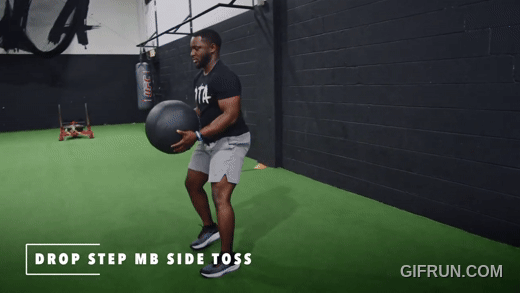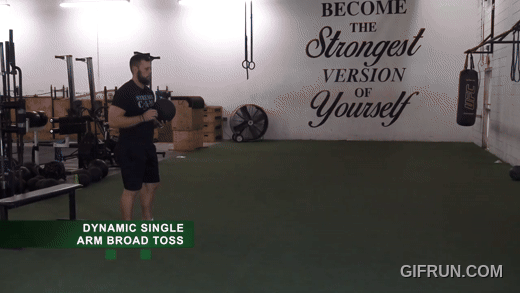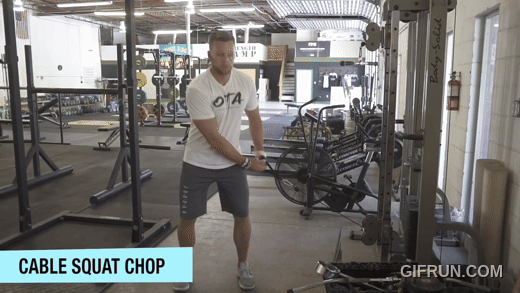Developing Rotational Power for Athletes
When most people hear “rotational power,” they immediately picture a baseball player cracking a 450-foot homerun or a golfer unleashing a 190-mph ball speed drive. And while those athletes absolutely rely heavily on rotational strength and speed, they aren’t the only ones who do.
Rotational power is a foundational human movement pattern. It’s not specific to one sport — it’s a full-body expression of force that drives performance in boxing, golf, softball, tennis, volleyball, lacrosse, hockey, football receivers and quarterbacks, field events, MMA, and even soccer. Any athlete who must turn the hips, transfer weight, or whip the torso to create force needs rotational power.
Yet many athletes (and even plenty of coaches) misunderstand how rotational power is built. It isn’t just doing Russian twists, cable rotations, or swinging a med ball. True rotational power is produced from the ground up — integrating the hips, core, and upper body into one fluid, explosive chain.
Below, we break down:
-
What rotational power actually is
-
Why it’s essential for nearly every sport
-
The biomechanics behind elite rotational athletes
-
Three effective rotational power/strength exercises athletes should be doing
What Is Rotational Power?
Rotational power is your ability to generate explosive force through twisting or turning the body. It’s the blend of:
-
Lower-body force production (hips, glutes, legs)
-
Core stiffness and elastic recoil
-
Upper-body speed and coordination
-
Timing and sequencing of the kinetic chain
Think of it as a whip: power starts at the ground, transfers through the hips, accelerates through the torso, and finally releases through the arms. All rotational force starts from the ground up, which is why we also focus heavily on improving athlete’s vertical power. Higher vertical almost always results in improved rotational power. Check out Elite Vertical Academy with the link below to get your vertical jump numbers up:

Rotational power is both strength-based (producing force) and skill-based (transferring energy efficiently). The stronger your foundation and the cleaner your mechanics, the faster and more powerfully you’ll rotate.
Why Rotational Power Matters Across Sports
Baseball and Softball
Hitting and pitching rely almost entirely on the ability to produce rotational force. Your hips fire, torso follows, then arms — creating bat speed, exit velocity, and velocity off the mound.
Golf
The golf swing IS rotational power. Better sequencing equals more club speed, ball speed, and longer drives without forcing the swing or increasing injury risk.
Boxing & Combat Sports
Punches generate power from the hips, not the arms. Elite fighters rotate through the hips, core, and shoulders to snap punches with knockout power.
Tennis
Forehands, backhands, serves — they are all rotational actions, requiring high-velocity hip rotation and elastic recoil through the trunk.
Volleyball
Rotational force powers spikes, serves, and even lateral defensive movements. The harder a player rotates their hips and core, the more force they can deliver overhead.
Football
Quarterbacks, wide receivers, safeties, and running backs all rotate violently on cuts, throws, blocks, and tackles.
Track & Field
Shot putters, javelin throwers, and discus athletes rely on rotational strength to produce massive force in a split second.
Soccer
Striking the ball — especially long passes and powerful shots — uses the same hip-to-trunk rotational sequence.
In short: If your sport requires you to swing, throw, strike, cut, rotate, or transfer power from the lower body to the upper body…
You need rotational power.
The Biomechanics of Elite Rotational Athletes
Whether you study a pro golfer, a high-level baseball hitter, or an Olympic thrower, the same biomechanical principles show up consistently:
1. Strong, explosive hips
The hips initiate nearly all power rotations. Hip internal/external rotation speed is a huge predictor of rotational force. Again, improving vertical is a major factor in developing more explosive hips. The athletes initiate force vertically from the ground up.
2. A stiff, reactive core
Rotational power is transferred through the core. The midsection acts like a spring:
-
It stiffens to absorb force
-
Releases like elastic recoil
-
Transfers energy to the upper body
This is why having a strong and stable trunk matters.
3. Proper sequencing
Elite athletes rotate with a specific timing pattern:
Hips → Torso → Shoulders → Arms/Implement
If that sequence breaks down, power drops — even if the athlete is strong.
4. Mobility AND stability
Two areas matter most:
-
Thoracic spine mobility (to rotate effectively)
-
Hip mobility (internal/external rotation for clean mechanics)
Combined with:
-
Core stability (anti-extension + anti-rotation)
-
Lumbopelvic control
The perfect mix allows the athlete to rotate FAST without losing posture or leaking force.
The 3 Best Exercises for Developing Rotational Power
There are dozens of rotational drills out there — some great, many useless. But if you want the MOST transfer to sport, the exercises below should be the core of your rotation program.
These aren’t bodybuilding motions. They build movement skill, strength, and explosive transfer.
1. Med Ball Side Toss/Drop Step Med Ball Side Toss
This is a 2 for 1. First drill is more stationary followed by a more dynamic/higher output variation of the same drill. The med ball scoop side toss and the drop-step side toss are two of the most effective rotational power drills for athletes. Together, they train both pure rotational force and the ability to create that force after a dynamic weight shift — exactly what happens in baseball, softball, boxing, tennis, golf, volleyball, football throwing mechanics, and virtually any sport requiring high-velocity rotation.
Med Ball Scoop Toss (Side Scoop Throw)

This drill develops maximal rotational power by training the hips, trunk, and upper body to fire in the correct sequence.
To perform it, stand sideways to a wall with the ball held near your back hip. Shift into a strong back hip load, then rotate violently toward the wall, letting your hips start the movement and your torso whip through naturally before releasing the ball. The goal is to throw through the wall, not at it, emphasizing speed over brute strength.
What it works and improves:
-
Trains the full kinetic chain from the legs through the torso.
-
Reinforces timing and sequencing for explosive rotation.
-
Rotational acceleration and power
-
Bat speed, punching power, and swinging mechanics
-
Full-chain force transfer
This drill builds bat speed, punching power, rotational acceleration, and full-chain force transfer.
Drop-Step Side Toss (Drop-Step Scoop Throw)
The drop-step variation adds momentum and reactive hip loading, making it even more sport-specific. Start in an athletic stance, sideways to the wall. Hold the ball near the back hip, then execute a drop step: the lead foot steps away and slightly backward, creating space and naturally loading the back hip. As soon as your foot lands, rotate explosively and launch the ball with a scoop-style release. The drop step creates stretch, coil, and momentum — and the throw teaches you to convert that into raw rotational output.
What it works and improves:
-
Teaches more rapid transfer of force from the ground through the hips and torso to the arm.
-
Reactive rotational power
-
Explosive hip-to-torso-to-arm sequencing
-
Sport-specific rotational acceleration
2. Dynamic Med Ball Single Arm Shotput/Broad Toss

The Dynamic Shot Toss (Single-Arm Broad Toss) is a high-velocity rotational power drill that develops upper-body speed and full-body force transfer. Incorporating a running or approach step, it teaches athletes to generate momentum from the ground and release it explosively through the torso and arm. This is essentially an overspeed drill to create a much higher output and transfer of rotational force than the more stationary scoop toss.
What it works and improves:
-
Trains the full kinetic chain from legs to arm.
-
Adds horizontal momentum for greater force output.
-
Reinforces higher velocity arm and torso rotation (overspeed effect)
-
Explosive rotational power
-
Reactive ground-to-upper-body force transfer
3. Cable Squat Chop (Rotational Strength)

The Cable Squat Chop is a versatile drill that develops rotational strength and power by forcing the athlete to generate force through the legs and hips, transfer it through a stable torso, and release it through the upper body. Unlike med ball tosses, it adds resistance to the rotational movement, making it ideal for building both strength and explosive rotational capacity. This is a great strength exercise for helping athletes build rotational strength and power with controlled resistance while reinforcing full-body force transfer.
Why it works and what it improves:
-
Adds resistance to the rotational movement, forcing the core and hips to produce more force
-
Strengthens the kinetic chain, improving the efficiency of hip-to-torso-to-upper-body force transfer
-
Reinforces hip-to-torso-to-arm sequencing under load, building durable, transferable power
-
Builds rotational strength from ground up through the hips and core
-
Sport-specific movements like hitting, throwing, and swinging
Final Thoughts
Rotational power is one of the most universal athletic skills — a combination of lower-body force, core stability, hip speed, and upper-body coordination. If your sport requires swinging, throwing, striking, or even cutting, you need to train rotation intentionally and explosively.
Build a foundation with lower body max strength to develop powerful hips and anti-rotation work. Improve trunk rotational strength and stability. Then unleash speed with dynamic rotational med ball throws.
Check out our Baseball Performance System with the link below if you’re trying to improve your hitting and throwing power this offseason!

